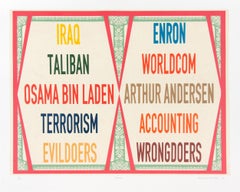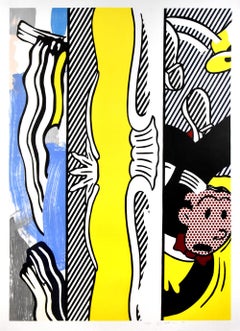Archie Scott Gobber Art
to
1
Overall Width
to
Overall Height
to
1
1
1
1
1
1
1
1
1
1
9,989
2,754
1,377
1,375
1
Artist: Archie Scott Gobber
Doers
By Archie Scott Gobber
Located in Kansas City, MO
Archie Scott Gobber
Doers
Year: 2004
8 Color Lithograph
Edition: 24
Paper: Somerset, Soft White
Paper Size: 30 x 38.25 inches
Image Size: 26 x 35.25 inches
Signed and numbered by hand
COA provided
------------------------------
Archie Scott Gobber is an artist currently living and working in Kansas City, Missouri, who is known for eye-catching works that employ clever wordplay as a vehicle for social and political commentary.
Category
Early 2000s Pop Art Archie Scott Gobber Art
Materials
Lithograph
Related Items
Two Paintings: Dagwood
By Roy Lichtenstein
Located in Palo Alto, CA
Roy Lichtenstein Two Paintings: Dagwood, 1984 is a vivid, colorful piece that demonstrates the clever work of Lichtenstein’s varied oeuvre. The work is c...
Category
1980s Pop Art Archie Scott Gobber Art
Materials
Lithograph, Woodcut
Fats Domino
By Red Grooms
Located in New York, NY
Red Grooms’ “Ruckus Manhattan” in the mid-1970s humorously transformed Grand Central Terminal into a 3-D caricature of New York City. “I wanted to do a novelistic portrait of Manhattan from Battery Park to Grant’s tomb,” Grooms explained. The comic-book inspired interactive installation included iconic landmarks—the subway, Central Park, the Apollo Theater...
Category
1980s Pop Art Archie Scott Gobber Art
Materials
Lithograph
Olympic Robe
By Jim Dine
Located in New York, NY
Signed, dated, and numbered
Category
20th Century Pop Art Archie Scott Gobber Art
Materials
Lithograph
NEW MOON Signed Lithograph, Red Moon, Zen Monk, Umbrella, Meditation
By Peter Max
Located in Union City, NJ
NEW MOON is an original hand drawn lithograph by the renowned American Pop artist, Peter Max, printed in an edition of 150, using traditional hand lithography techniques on archival Arches paper, 100% acid free. NEW MOON is a mesmerizing, transcendental composition depicting a large red moon rising among the clouds, as a long robed Zen monk...
Category
1990s Pop Art Archie Scott Gobber Art
Materials
Lithograph
$4,480 Sale Price
20% Off
H 27 in W 36 in
FLOWER SPECTRUM II Signed Lithograph, Pop Art Lady Portrait Head, Pink, Green
By Peter Max
Located in Union City, NJ
FLOWER SPECTRUM II is an original hand drawn lithograph by the American Pop artist Peter Max printed in an edition of 150, using traditional hand lithography techniques on archival paper. FLOWER SPECTRUM II is a pop art lady portrait head depicting a graceful female profile of a goddess woman crowned in leaves and flowers, printed in deep raspberry rose...
Category
1990s Pop Art Archie Scott Gobber Art
Materials
Lithograph
$3,040 Sale Price
20% Off
H 27 in W 36 in
Free South Africa (#1), 1985
By Keith Haring
Located in Greenwich, CT
Keith Haring's Free South Africa series deftly addresses the nature of South Africa's apartheid regime in Harng's unique and succinct visual language. Signed, dated, and numbered low...
Category
20th Century Pop Art Archie Scott Gobber Art
Materials
Lithograph, Paper
NOTES (KASSEL)
By Claes Oldenburg
Located in Aventura, FL
Hand signed and numbered by the artist. Edition of 100. Sheet size 23 x 15 in. Framed. Artwork is in excellent condition. Certificate of Authenticity is included. All reasonable of...
Category
1960s Pop Art Archie Scott Gobber Art
Materials
Paper, Lithograph
DRESSED UP Hand Drawn Lithograph, Abstract Fashion Drawing, Pop Art
By Peter Max
Located in Union City, NJ
DRESSED UP is an original hand drawn lithograph by Peter Max printed in an edition of 280, using traditional hand lithography techniques on archival paper, 100% acid free. DRESSED UP...
Category
1980s Pop Art Archie Scott Gobber Art
Materials
Lithograph
$638 Sale Price
20% Off
H 7 in W 7 in
Odyssetron I (From the suite of 5 lithographs)
Located in San Francisco, CA
This artwork titled "Odyssetron I" 1982 is an original color lithograph by American PopArt artist Bryan Rogers, 1941-2013. It is hand signed and numbered ...
Category
Late 20th Century Pop Art Archie Scott Gobber Art
Materials
Lithograph
Read Head
By Richard Lindner
Located in San Francisco, CA
This artwork titled "Red Head" 1971 is an original color lithograph on Wove paper by artist Richard Lindner (German/American 1901-1978) It is hand signed and inscribed A.P (Artist Pr...
Category
Mid-20th Century Pop Art Archie Scott Gobber Art
Materials
Lithograph
Morning Mirror
By James Rosenquist
Located in Palo Alto, CA
James Rosenquist Morning Mirror, 1966 is a mesmeric piece that captures your attention with the use of 3 colors; red, yellow, and grey. Front and center, in the middle of the composi...
Category
1960s Pop Art Archie Scott Gobber Art
Materials
Lithograph
Portrait #1 from After Noon suite
By Richard Lindner
Located in San Francisco, CA
This artwork titled "Portrait #1" from the suite "After Noon" 1976, is an original color lithograph on Arches paper by artist Richard Lindner (German/American 1901-1978) It is hand s...
Category
Mid-20th Century Pop Art Archie Scott Gobber Art
Materials
Lithograph
Archie Scott Gobber art for sale on 1stDibs.
Find a wide variety of authentic Archie Scott Gobber art available for sale on 1stDibs. If you’re browsing the collection of art to introduce a pop of color in a neutral corner of your living room or bedroom, you can find work that includes elements of blue and other colors. You can also browse by medium to find art by Archie Scott Gobber in pigment print, archival pigment print, digital pigment print and more. Much of the original work by this artist or collective was created during the 21st century and contemporary and is mostly associated with the contemporary style. Not every interior allows for large Archie Scott Gobber art, so small editions measuring 16 inches across are available. Customers who are interested in this artist might also find the work of Sophie Matisse, Jessica Stockholder, and Sara Zielinski. Archie Scott Gobber art prices can differ depending upon medium, time period and other attributes. On 1stDibs, the price for these items starts at $1,121 and tops out at $1,770, while the average work can sell for $1,121.

